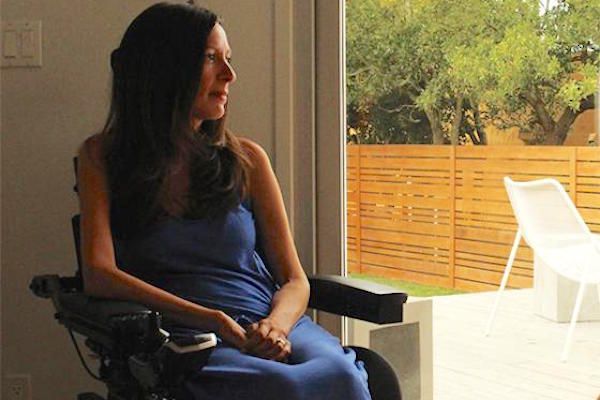It all began with the weakness in her legs. Three years after moving back to the Bay Area from New York City, Sarah Coglianese and her husband lived an active life. She was a runner, he was a cyclist. They had a new baby daughter, Scarlett, and were settling into their Balboa Terrace home. Then in 2011, she started to fall.
In June 2012, having already ruled out HIV, cancer and Lyme disease, a neurologist gave Coglianese an official diagnosis: amyotrophic lateral sclerosis (ALS), more commonly known as Lou Gehrig’s Disease.
The disease wasn’t totally foreign to Coglianese who, in her publishing career, had worked with ALS patients-turned-memoirists. But the severity of the disease hadn’t quite registered with her then. After all, the general public largely associates Lou Gehrig’s with men of a certain age. Coglianese was a 33-year-old woman.
“The way that I cried, and the noises that were coming out of my mouth, I had never heard anything like it,” she recalls of that fateful day. “Everyone was calling it Lou Gehrig’s disease…I see pictures of him on websites in black and white, and I could think it’s an old disease.”
But in reality, an estimated 5,600 people are diagnosed with ALS each year; just under half are women, and a large portion of them are under 40, according to the ALS Association.
Last August, the disease went digitally viral thanks to the Ice Bucket Challenge, which saw YouTubers and celebrities (everyone from Amy Schumer to Mark Zuckerberg) dumping buckets of ice water over their heads to raise awareness around the disease. But the consensus among ALS patients and researchers? The movement, however attention-grabbing, didn’t do much to raise awareness for how debilitating the disease really is.
“The thing that’s hardest for me isn’t dying, but the idea of becoming disabled,” says Coglianese, who has become painfully aware that having ALS means she can’t fully care for her daughter, Scarlett, for now or at all for very much longer. Now 36, Coglianese is wheelchair-bound with a disease that typically proffers an average life expectancy of three to five years. She’s having difficulty breathing (many ALS patients die of paralysis of the lungs), and her right arm is noticeably weaker than her left.
“The biggest problem with ALS is that every case of ALS is different,” says Rob Goldstein, vice president of ALS Therapy Development Institute (ALSTDI), a research group that dedicates 100 percent of its funding to drug research and development. Because unfortunately, as Goldstein points out, funding for ALS research pales in comparison to the dollars donated to more prominent fatal illnesses. According to the National Institute of Health (NIH), ALS research will receive only an estimated $50 million in federal grants in 2016. Breast cancer, which is expected to affect more than 230,000 women in new cases this year alone, will receive $704 million; HIV/AIDS research is slated to receive $3.1 billion.
Coglianese is taking it upon herself to ramp up funding and awareness for ALS. Her “What Would You Give” campaign this August asking volunteers to give up one bodily function (walking, dressing, using their hands) in order to shed light on what living with ALS is actually like. So far, the experiment has already uncovered challenges with regard to Bay Area businesses’ compliance (or lack thereof) with ADA guidelines.
Robert Becker, a senior talent development manager at Salesforce, decided to give up the use of his legs for one day. And then he got to the BART station.
“I've never thought much about what it would take to get from the BART parking lot down to the BART platform in a wheelchair,” Becker wrote in a blog post. “There is an elevator at the North Berkeley BART station, but it's located far away from the actual entrance to the station. So if one takes the elevator down, how does one pay for the train fare? And parking? Two separate answers to those questions. One simple. One not so much.”
While Coglianese is fortunate to have an in-home caretaker to help with household duties and driving, every day she faces the frustration of having to explain the gravity of her situation. “It’s hard to say to a stranger that I won’t live to do things. It tends to be a serious conversation you don’t want to have at someone’s gymnastics class,” she says. “But I’m in the business of education.”
“Sarah is one of the sweetest people. Nothing happens in research without people like her,” says ALSTDI’s Goldstein.
These days, Coglianese tries to share her story as much as possible via her own blog. She has also written for The New York Times’Motherlode, and her story has been published in Redbook.
The “What Would You Give” campaign reached its $100,000 goal as of press time and has raised the goal to $120,000. The campaign continues through the end of this month. You can donate here.
Related Articles
